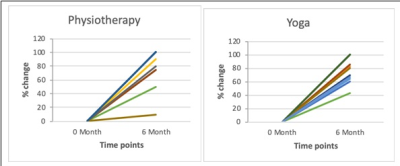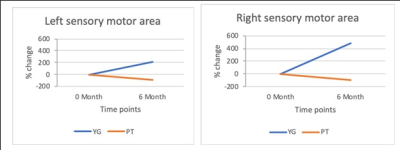4600
Using fMRI to compare physiotherapy and yoga-induced changes in post-stroke rehabilitation1NMR, All India Institute of Medical Sciences, Delhi, India, 2Neurology, All India Institute of Medical Sciences, Delhi, India
Synopsis
This study has compared using fMRI, the changes effected by physiotherapy and yoga in post-stroke recovery. Ischemic stroke patients (n=20) with motor deficits were divided into two groups - yoga and physiotherapy. Each group practiced yoga or physiotherapy for one hour daily for six months, under the supervision of certified yoga trainers and physiotherapists, respectively. Pre- and post- (6 months) intervention evaluations were carried out using fMRI at 3T and NIHSS scores. Results show significant improvement in the NIHSS scores and BOLD activity in the affected sensory motor region of the stroke patients in the yoga group compared to physiotherapy.
Introduction
Stroke is a debilitating disease resulting in economic consequences not only for the individual but also for the nation.1 Although physiotherapy is a conventional modality for post-stroke rehabilitation,2 there is also a growing attention in the therapeutic use of yoga.3 The objective of this study is use fMRI to evaluate and compare the yoga and physiotherapy-induced changes in post-stroke rehabilitation of ischemic stroke patients.Material and Methods
Patient recruitment and assessment: Twenty first-ever left hemisphere stroke patients (18-60 years) were enrolled for the study after written informed consent and with approval from the Institute Ethics Committee. All the patients had motor deficits with NIHSS (National Institute of Health Stroke Scale) score for left hemisphere < 15 and right hemisphere < 10.Physiotherapy and yoga intervention: The enrolled subjects were divided in yoga and physiotherapy groups. Patients from the two groups did respectively, yoga and physiotherapy for six months (one hour everyday) under the supervision of certified yoga trainers and physiotherapists. The therapeutic response was assessed by NIHSS scores, pre- and post- (6 months) yoga and physiotherapy interventions.
MR studies: fMRI was carried out pre- and post-(6 months) interventions at 3T (Ingenia, Philips) and involved unilateral and bilateral motor tasks (closing and opening the fist). Single-shot EPI (Echo Planner Imaging) sequence was used for the BOLD (Blood Oxygen Level Dependent) study with the following parameters: slices 35, slice thickness 4 mm, repetition time 2000 ms, echo time 30 ms, acquisition matrix size 76x74, number of dynamics - 180. fMRI data were analysed using the CONN toolbox based on Statistical Parametric Mapping [SPM 12 (Wellcome trust, London, UK)]. Time series data from precentral gyrus region were extracted using brain atlas (Talairach Atlas Labels) and Automated Anatomical Labeling Atlas. Longitudinal comparative analysis of all the time series was carried out and the results presented as frequency distribution for each patient.
Results
Longitudinal changes in clinical NIHSS score are shown for all patients as percentage improvement (Fig. 1). The difference in the mean percentage change in patients in physiotherapy (80%) and yoga (81%) groups were not significant, although there were significant individual differences. However, within the group the differences between pre- and post-interventions were significant (p > 0.05). Similar pattern was observed in the fMRI activation in precentral gyrus. The changes observed in left and right sensory motor areas in response to bilateral motor task are presented in Figure 2. At 6 months post-yoga intervention, this group of patients showed a 199% increase in activation of left sensory motor area and 468% increase in activation of right sensory motor area. On the other hand, the physiotherapy group showed -87% decrease in activation of left sensory motor area and -81% decrease in activation of right sensory motor area. The results indicate the increase in activity in the contralateral region of brain. Although the group analysis showed significant (p > 0.05) improvement in the functional activity post-yoga intervention compared to physiotherapy, further in-depth analysis is under way.Conclusion
Stroke significantly affects the health of individuals and also economy of the nation, especially if the patients are young adults contributing to the nation’s workforce. Post-stroke rehabilitation plays a very important role in stroke management. With increasing number of reports on therapeutic benefits of yoga along with its cost-effectiveness,3,4 there is growing interest in using it in addition to the conventional physiotherapy in post-stroke rehabilitation. With this in focus, this study has attempted for the first time in literature to compare and understand the changes effected by the conventional physiotherapy with those by yoga using fMRI in ischemic stroke patients. The preliminary results and analysis have shown that the functional recovery of motor task with yoga compares better than those with physiotherapy. However, the differences observed in the individual responses are also interesting and further in-depth studies and analyses are under way.Acknowledgements
The work was supported by SATYAM scheme, Department of Science and Technology, Government of India.References
1. World Health Organization, Global Action Plan for the Prevention and Control of NCDs 2013-2020. (https://www.who.int/publications/i/item/9789241506236) (accessed on 10 Nov 2021)
2. http://www.strokeassociation.org/STROKEORG/LifeAfterStroke/RegainingIndependence/Physical Challenges/Post-Stroke-Rehabilitation_UCM_310447_Article.jsp#.W-KLoKeB1Bw, American Stroke Association
3. Jeter PE, Slutsky J, Singh N, Khalsa SBS. Yoga as a therapeutic intervention: a bibiometric analysis of published research studied from 1967 to 2013. J Comp Alt Med, 2015: 1-7, 2015.
4. Sovova E, Cajka V, Pastucha D, et al. Positive effect of yoga on cardiorespiratory fitness: A pilot study. Intl J Yoga. 2015, 8: 134-138.
Figures

